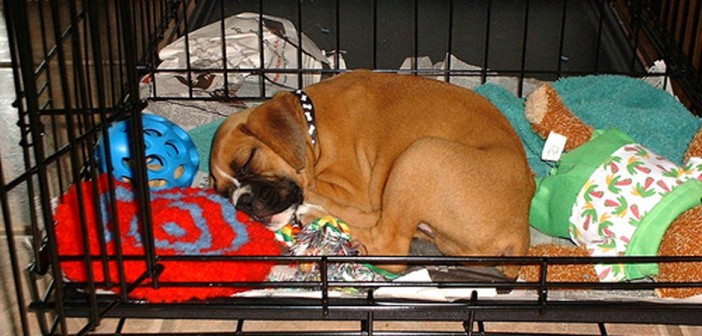When our dog was a puppy we worried that almost everything we were doing was wrong. “Should we take her out again?” I would say to my husband watching her vigorously smell the carpet only 10 minutes after we’d just taken her out. “Do you think she’s hungry?” I’d ask since she stood over her just emptied bowl. “Maybe she’ll stop barking if we let her out of the crate,” my husband would mutter at 1 A.M.
Then I remember that first night we brought her home and tried to be firm by putting her in her crate far away from our room only to have her barks break our heart – and most likely anger the neighbors – and soon she ended up, still crated, but next to my bedside, with my finger patting her every so often through the metal bars of the crate.
Yet soon we discovered that as anxious and uncertain as we felt as first-time dog owners, the crate eased our stress — as well as the dogs.
Teaching our dog to be in the crate for short periods of time, as well as during the night, helped us potty train our dog rather than watch her constantly like an unpredictable sprinkler system, ensured she was safe when we were gone, and slowly gave her the confidence to peacefully sleep through the night without me petting her head every so often.
Yet as she grew, her crate, which for years had seemed the right and obvious solution, started to become a question mark for us. She was happy nestled on the couch when we were outside working in the garden, she was most certainly housebroken and had outgrown her curiosity for power cords and houseplants, and while she still liked her crate, she didn’t seem to need it like she used to. This led to discoveries on how to crate a trained dog:
Remember the basics:
Dogs should be crated to provide them with a den environment that they are genetically accustomed to in the wild. Since dogs don’t like to soil their dens, crates can help housebreak a dog. Also, because a dog’s den, or crate, should be a source of comfort and safety for them, it can be a bed for them to go to when they’re tired, the house is chaotic, or a thunderstorm occurs. This element of safety also ensures they stay out of trouble when you’re not home.
A crate is not a babysitter:
Often when people have misguided ideas about crates they can think they are cruel; however, when done properly a crate is just the opposite. A crate is supposed to be a safe and secure place for your pet, as well as a training tool, but in no way a babysitter. Your dog should be exercised for 30-60 minutes before and after being put in the crate, and up to 90 minutes before and after a full night in the crate. Additionally, they should first eliminate before being put in the crate, and the crate should have items that will be safe for them and can keep them busy or lull them to sleep, like a Kong filled with peanut butter.
The crate has a time limit:
Dogs should not be left in the crate for more than 4-5 hours on a regular basis, less for a new puppy. Though once in a while your dog can be left in the crate for 6-8 hours, this should never be a regular schedule for them and should be avoided when possible. If you leave your dog in the crate for eight hours daily, or more than eight hours occasionally, they will not get the amount of attention and exercise they need. Because of this, working pet owners should hire someone to walk their dog mid-day, or come home mid-day to walk their dog, as well as exercise them and give them attention both in the morning and at night. If this isn’t an option, there are reputable pet sitters and doggie daycares.
Don’t loose sight of the purpose of a crate:
As your dog becomes housebroken, trustworthy, and more independent explore leaving them home alone with the crate door open so they can come and go as they please. For their safety, start with an area, such as a crate with a pen around it or a safe room in your house like the bathroom. Even if your dog appears comfortable and trustworthy, be sure there’s nothing they can harm themselves with in the area you leave them, as some dogs can behave differently if they feel anxious when you leave.
Avoid separation anxiety:
Just like when you crate them, don’t make a big deal about your leaving or returning when you leave them home alone. Dogs play on your emotions and if you seem anxious or excited they will adopt those tendencies and develop anxious, and sometimes destructive, tendencies when left alone.
Consider the unique personality of your pet:
Though every dog is different, crating should never be a misused training tool, no matter your pet’s age. Look for signs in your pet of what makes them most comfortable, and what your deem the safest solution, and work toward creating an environment that both remembers this, as well as grows with the maturity of your pet.
What can make training a dog difficult is the unique personality of every dog, yet that is also what makes your pet so special and irreplaceable to you.





2 Comments
I sure wish I had crate trained my dogs, I instead taught her to sleep on the bed so I’d know when she had to go out and now that she is a 100 lb dog she still sleeps on the “bed” or rather me :). I love my dogs dearly!
I enjoyed reading this and wish I would have read it before I brought home my bundle of joy. I didn’t follow the rules, bent them a bit. He now goes to Doggie Daycare twice a week and loves it.